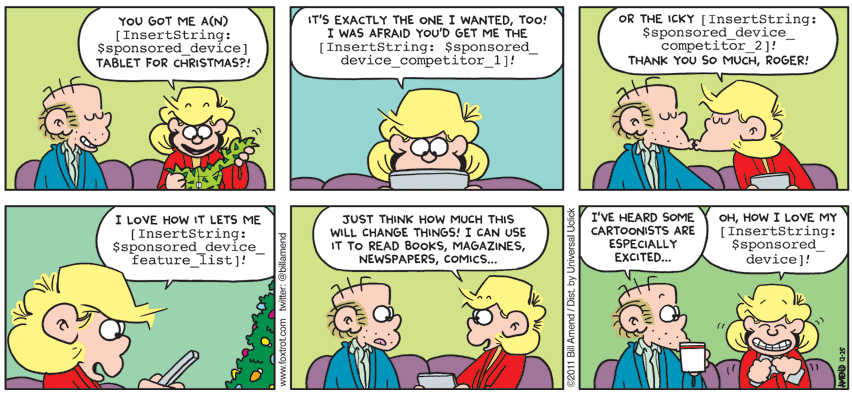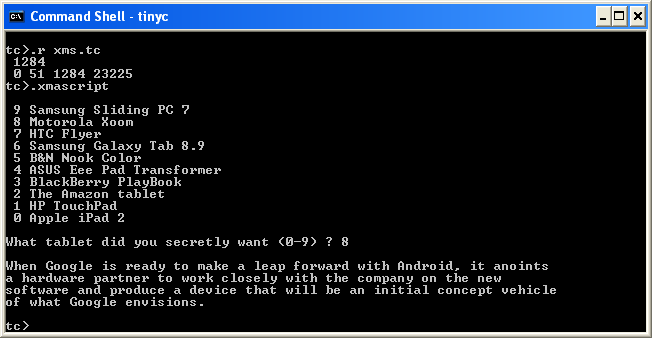

http://www.zdnet.com/blog/btl/top-10-tablets-of-2011-the-new-leaderboard/48214
9. Samsung Sliding PC 7 A Windows 7 tablet that is legitimately intriguing is Samsungís Sliding PC 7. It looks like a normal 10-inch tablet, but includes a slide-out keyboard that turns it into a fully functional laptop. The hardware manages to deftly combine slimness with keyboard usability, based on the demo at CES. For those who donít want to carry both a laptop and a tablet, hybrid devices like this could carve out a new niche. This one has a 1366◊768 screen, up to a 64GB solid state drive, 2GB of RAM, and built-in 3G and WiMAX chips. Since it runs all of that hardware and the full version of Windows, battery life will be a concern. It also costs $650 and tablets over $600 have not been very well received by the public. 8. Motorola Xoom When Google is ready to make a leap forward with Android, it anoints a hardware partner to work closely with the company on the new software and produce a device that will be an initial concept vehicle of what Google envisions. For its Android 3.0 tablet OS, Motorola was the chosen one. And, interestingly enough, the Motorola Xoom was not only be the first Honeycomb tablet, but also the first tablet to run on Verizonís new 4G LTE superhighway. This 10-inch widescreen tablet has drool-inducing tech specs but the Android tablet software is incomplete and desperately needs more apps. The other big drawback is the price. It retails for $799 without a contract. Even the Wi-Fi version is $599. It will be tough to justify that price until Google cleans up Honeycomb and gets app builders on board. Read full review. 7. HTC Flyer Half of the tablets on this list are powered by Android and HTC is one of the powerhouses of the Android ecosystem. Unlike rivals Motorola, Samsung, and LG, who all unveiled high-end tablets at CES 2011, HTC was remarkably silent on the tablet question in Vegas. However, the company officially announced its first tablet a month later at Mobile World Congress in Barcelona. It is the HTC Flyer and itís a 7-incher with 1.5 GHz CPU, 1.0 GB RAM, 32GB of Flash storage, an attractive unibody design, and a special version of the HTC Sense UI designed for tablets. Unlike most of the other Android tablets, the Flyer also includes digital ink technology and a stylus. However, the Flyer will not run Android 3.0. Instead, it will launch with Android 2.3 Gingerbread. Given the problems with Honeycomb and HTCís strong track record with its Sense UI, this could be a very usable little tablet. 6. Samsung Galaxy Tab 8.9 The original Samsung Galaxy Tab was a 7-inch tablet that jumped the gun on Android tablets before Google was ready but it also offered the first legitimate challenge to the iPad. If it wasnít so expensive ($600), it might have faired even better than the respectable sales numbers that it posted. Samsungís second try at the tablet market looks a lot more potent. Running the official Android tablet OS this time, Samsung is preparing to launch 8.9-inch and 10.1-inch versions of the Galaxy Tab in mid-2011. The 8.9-inch model could prove to be the most attractive, since itís a little smaller than the 10-inch tablets like the iPad and the Xoom, which can be slightly awkward to hold and enter data. Plus, the Samsung Galaxy Tab has a great price tag ó $439 for the Wi-Fi model ó and Samsung is making these tablets very friendly for enterprise buyers. 5. B&N Nook Color The Barnes & Noble Nook Color e-reader recently got an update to Android 2.2 and its own app store, which has turned it into a viable low-cost tablet. Some will argue against it since it has a heavy-handed UI forced on top of Android and doesnít run the full Android Market app store. But, I couldnít leave this little 7-inch tablet off the list. It has a great form factor ó thin and easy in the hands ó and you canít beat the price at $249. Plus, if youíre highly technical, you can hack it into a full Android tablet. 4. ASUS Eee Pad Transformer ASUS believes that the iPad has two weaknesses ó lack of choice and limited productivity (content creation) ó so thatís where the company is focusing its energy in tablets. At CES, ASUS unveiled its line of four tablets, and three of them were aimed at content creators. The most interesting was the Eee Pad Transformer, a 10-inch tablet with a dual core NVIDIA Tegra 2 CPU that runs Android 3.0. The most innovative thing about this one is that it has an optional keyboard dock that also functions as an extended battery, giving the device up to 16 hours of life. ASUS has pulled off an Android tablet that also doubles as a laptop when the Transformer is in dock mode. Plus, the price is right. At $399, this tablet is one of the best values on the market, so itís no surprise that it it sold out in the US on its first day of online sales. 3. BlackBerry PlayBook I was at the event last fall where RIM announced the BlackBerry PlayBook and my first impressions were not very good ó mostly because RIM kept it behind glass. However, after getting my hands on the final product, I was a lot more impressed. The PlayBook looks like it could become a factor in the tablet market, especially for businesses that are already invested and committed to the BES backend infrastructure. This is a 7-inch tablet, so that limits its appeal a bit ó except for the vocal minority who like the smaller form factor. Still, the hardware feels great, the tablet OS is easy to figure out, and the performance is staggeringly good. BlackBerry die-hards alone could turn this one into a winner. Itís also the best tablet for Web browsing because of its excellent implementation of Flash. 2. The Amazon tablet Amazon appears to be putting all the pieces in place to build its own Android tablet. In fact, it may be better positioned to compete with Apple than any of the other tablet makers because of its strengths in content and cloud computing. Amazon already had the Kindle e-book library and Web-based music and video stores, but in 2011 it has added the Amazon Appstore for Android and Amazon Cloud Drive. Plus, the word out of Asia is that Amazon is prepping a low-cost tablet using an E-ink display. Amazon hasnít made any announcements yet, so this tablet benefits from lots of positive speculation, but the stars appear to be aligning for a formidable tablet product from the worldís e-commerce king, which will likely price it low and make money off the content sales. 1. HP TouchPad I think we can safely call this one the ďX factor.Ē Even after Hewlett-Packard officially unveiled its webOS tablet on February 9, there are still two big questions hanging out there - when exactly will it arrive (ĒsummerĒ is all we know) and how much will it cost? This product has been in the works since HP bought Palm last summer. Putting the resources of HP behind the massive potential of webOS could be great combination. Also, donít forget that HP has a decade of experience building tablet hardware ó even if it was as part of the long defeat for Microsoftís Tablet PC. HPís new TouchPad is 9.7-inch tablet with lots of high-end features, but it doesnít have much to distinguish it from Apple or Android and that could hurt. The tablet will likely succeed or fail based on price. If it is comparable to the iPad ($500) while offering a stronger feature-set, it has a shot. If itís more expensive than the iPad then it could struggle. Still, the WebOS is a natural fit for tablets and the TouchPad could potentially trump the iPad in true multitasking, better integrated notifications, and messaging. 0. Apple iPad 2 The iPad remains the king of the category and, even with the invasion of an army of challengers, itís difficult to see a scenario in which the iPad wonít retain a commanding market share lead when we get to the end of 2011. It still has too many factors in its favor: usability, battery life, a massive catalog of apps, and price. The last factor might be the most important. In 2010, price was the iPadís greatest marketing weapon as rivals had a very hard time meeting the iPadís price tag while offering a comparable experience. The iPad 2 doesnít offer any revolutionary new changes. Itís thinner and lighter, has an upgraded processor and display, and adds front and rear cameras. Itís a nice refinement, and with its big advantages in app and content libraries, it easily has enough value to keep it at the top of the list. Read full review.